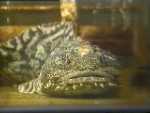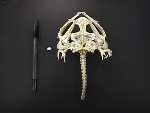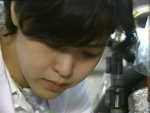 |
| toadfish |
At NASDA Tsukuba Space Center toadfish are being kept in order to supply
vital data for developing Vestibular Function Experiment Unit (VFEU). We
interviewed Ms. Naoko Murakami who is responsible for keeping the toadfish.
Q : Why is NASDA keeping these toadfish?
N.M. : One of the experiments of Neurolab Program "Chronic
Recording of Otolith Nerves in Microgravity" investigates the
otolithe neural activities of toadfish. In order to perform this experiment
the Vestibular Function Experiment Unit (VFEU/NDAS*) are being developed.
For conducting performance test or compatibility test of VFEU NASDA keeps
toadfish here in Tsukuba Space Center. This equipment will be used not
only for STS-90 mission, but also for STS-95 mission which NASDA Astronaut
Dr. Mukai has been assigned to board as Payload Specialist.
*NDAS : Neural Data Acquisition System
Q : Please give us some ecological information about the toadfish.
N.M. : Toadfish live in the sea, along the east coast of North American
continent. There are no toadfish along the coast of Japan. They live around
the depth of about five through ten meters where they can find place to
hide themselves. Their average life span is four or five years. They are
about 30cm in length and weigh about 1kg. They become as big as 45cm long
and 1.5kg in weight. They prefer to live in the sea of low temperature,
so here in NASDA the temperature of the water is kept at 14degrees centigrade.
 |
otolithe (left) and
frame (right) of toadfish |
Q : Why has the toadfish been chosen as the experimental object?
N.M. : The first reason is because the principal investigator Dr.
Highstein has been investigating toadfish for such a long time and has
great experience, and secondly, because evident functional difference of
otolithe organs has not been found among animals ranging from fish to high
level of animals, so it is supposed that the same phenomena which happen
to astronauts could also happen to fish. In addition, toadfish is flat
and has a big head for its body size, so its otolithe can be observed with
ease. The toadfish is also very strong.
Q : What is otolithe organs?
N.M. : It is an organ which senses acceleration. Neural signals
from otolithe organs to brain play essential roles in maintaining balance,
posture and movement adjustment.
Q : Will the toadfish to be on bard the Space Shuttle be selected out
of those being kept here in Tsukuba Space Center?
N.M. : The toadfish to fly aboard the Space Shuttle will be selected
out of those kept in the U.S. Due to the size of the equipment VFEU, toadfish
around 25cm and 350g, and healthy ones will be selected to be on board.
Q : Which sex of toadfish will be selected to be on board the Shuttle,
male or female?
N.M. : It is hard to judge the sex of toadfish from its outlook.
Only chance of distinguishing is the season when female has eggs with big
belly. Since there is no functional difference of the otolithe organs between
male and female, healthy ones will be selected just before the launch without
considering sex.
Q : What does toadfish prefer to eat?
N.M. : Small fish is their favorite food. They don't eat everyday,
so we feed them small pieces of horse mackerel or squid once a week. They
seem to have a special fondness to squid. The weight of food for one feeding
is seven to eight grams.
Q : Are they quick in action?
N.M. : When they are eating, they are very quick. The rest of the
time they almost don't move at all.
Q : Is the toadfish edible? How does it taste like?
N.M. : This is a frequently asked question. We can find almost no
edible part in the toadfish, so it hasn't been treated as food.
 |
| Ms. Naoko Murakami |
Q : Is it true that toadfish croak?
N.M. : When we scoop them up from the water to move them to another
water tank, some of them croak. When I heard it croak for the first time
I was very surprised.
Ms. Murakami smiled, saying that when she approaches the water tank the
toadfish swim towards her and that makes her very happy. Thanks a lot for
the interview, Ms. Murakami!
| 

